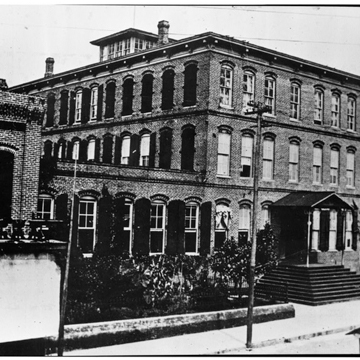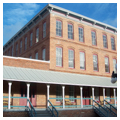The Ybor Factory Building marked the growth not only of Tampa as a city with industrial promise, but also reinforced the strong association between industry and politics that exists to this day in Florida. The original factory was the first brick cigar factory constructed in Tampa and, at the time of its completion, the largest cigar factory in the city, bringing industry to what had been, up that point, largely a farm town.
Cuban industrialists Vicente Martínez Ybor and Ignacio Haya came to Tampa looking for land on which to build a cigar factory. During the Ten Years’ War (1868–1878) Ybor left his successful cigar industry in western Cuba and fled to Key West, where his business continued to grow. He and Haya began looking for a new site to move their company due to labor unrest and following a fire in Key West. Undecided between a very lucrative deal in Galveston, Texas, and an opportunity in subtropical Tampa, which had ample supplies of wood, a deep port, and newly established train service, they ultimately chose the latter city since they were offered significant financial support from Tampa landowners. Ybor hired local architect C. E. Parcell, and within eighteen months of the purchase of the property, was the owner of the tallest structure in Tampa, along with a factory village of more than fifty wood-framed structures that served as workers’ housing.
Built in 1886, the original three-story factory building was constructed using load-bearing brick walls, segmental arched windows, and engaged heavy timber construction of columns and beams to support long expanses of wooden floors and ceilings. The factory, which accommodated 600 hand-rolling cigar makers (and “readers,” who sat on elevated platforms in the center of the space and read out loud to the workers) was an instant success. In 1889, additional bays were added to the original building. In 1895, a one-story addition connected the original factory building to East Ninth Avenue on the north and by 1902, an entire city block had been filled out with the addition of a sizable stemmery (where tobacco stems were removed in the cigar-making process), a water tower, several ancillary buildings, and a large warehouse to the west and south. The construction of a cluster of industrial buildings, a community of houses for families and transient boarders, a club, restaurants, and hotels for visitors and residents alike made for the creation of a city with many Cuban expatriates who had strong affiliations with organized labor and great antipathy for the Spanish colonial stronghold over Cuba.
Ybor City, as the area around the factory building came to be called, became a beacon for the revolutionary efforts of José Martí (1853–1895). Martí visited Tampa three times, and each time was welcomed by the cigar factory workers as a hero in the fight against Spanish oppression. In 1893, just two years before his death, Martí made a memorable speech on the stairs and porch that led to the main entrance of the factory. In that speech, he called for the Cubans of Ybor City to donate men, arms, and money to the cause of Cuban independence from Spain, which was ultimately granted in the aftermath of the Spanish-American War in December 1898. The speech was so important that the factory’s original cast-iron, three-sided front porch where Martí gave the speech was removed from the building and sent to Cuba as a celebration of its heritage. The current porch replaces the original and points to the importance of this entire factory structure to the social and political construction of Cuban-American relations in the late nineteenth century.
During the twentieth century, the collection of buildings around and including the original factory were neglected until the Church of Scientology purchased the site in 2011 and completed a thorough and impressive restoration of the exterior facades.
References
Barnes, Donald W., Jr., and Glenn Westfall, “Ybor Cigar Factory,” Hillsborough County, Florida. Historic American Building Survey, 1973. Prints and Photographs Division, Library of Congress (HABS FLA, 29-TAMP,19-).
Lastra, Frank Trebin. Ybor City: The Making of a Landmark Town.Tampa, FL: University of Tampa Press, 2006.




